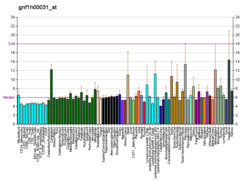Clinical significance
edit
^ a b c GRCh38: Ensembl release 89: ENSG00000106031 – Ensembl , May 2017^ a b c GRCm38: Ensembl release 89: ENSMUSG00000038203 – Ensembl , May 2017^ "Human PubMed Reference:" . National Center for Biotechnology Information, U.S. National Library of Medicine .^ "Mouse PubMed Reference:" . National Center for Biotechnology Information, U.S. National Library of Medicine .^ McAlpine PJ, Shows TB (July 1990). "Nomenclature for human homeobox genes". Genomics . 7 (3): 460. doi :10.1016/0888-7543(90)90186-X . PMID 1973146 . ^ Scott MP (November 1992). "Vertebrate homeobox gene nomenclature". Cell . 71 (4): 551–553. doi :10.1016/0092-8674(92)90588-4 . PMID 1358459 . S2CID 13370372 . ^ a b "Entrez Gene: HOXA13 homeobox A13" .^ Innis JW (2006-07-11). Hand-Foot-Genital Syndrome PMID 20301596 . ^ Janmaat VT, Nesteruk K, Spaander MC, Verhaar AP, Yu B, Silva RA, et al. (June 2021). "HOXA13 in etiology and oncogenic potential of Barrett's esophagus" . Nature Communications . 12 (1): 3354. Bibcode :2021NatCo..12.3354J . doi :10.1038/s41467-021-23641-8 PMC 8184780 PMID 34099670 .
Goodman FR, Scambler PJ (January 2001). "Human HOX gene mutations". Clinical Genetics . 59 (1): 1–11. doi :10.1034/j.1399-0004.2001.590101.x . PMID 11206481 . S2CID 38364372 . Utsch B, Becker K, Brock D, Lentze MJ, Bidlingmaier F, Ludwig M (May 2002). "A novel stable polyalanine [poly(A)] expansion in the HOXA13 gene associated with hand-foot-genital syndrome: proper function of poly(A)-harbouring transcription factors depends on a critical repeat length?". Human Genetics . 110 (5): 488–494. doi :10.1007/s00439-002-0712-8 . PMID 12073020 . S2CID 22181414 . Acampora D, D'Esposito M, Faiella A, Pannese M, Migliaccio E, Morelli F, et al. (December 1989). "The human HOX gene family" . Nucleic Acids Research . 17 (24): 10385–10402. doi :10.1093/nar/17.24.10385 . PMC 335308 PMID 2574852 . Apiou F, Flagiello D, Cillo C, Malfoy B, Poupon MF, Dutrillaux B (1996). "Fine mapping of human HOX gene clusters". Cytogenetics and Cell Genetics . 73 (1–2): 114–115. doi :10.1159/000134320 . PMID 8646877 . Mortlock DP, Innis JW (February 1997). "Mutation of HOXA13 in hand-foot-genital syndrome". Nature Genetics . 15 (2): 179–180. doi :10.1038/ng0297-179 . PMID 9020844 . S2CID 24522600 . Sanger Centre, Washington University Genome Sequencing Center (November 1998). "Toward a complete human genome sequence" . Genome Research . 8 (11): 1097–1108. doi :10.1101/gr.8.11.1097 PMID 9847074 . Post LC, Innis JW (December 1999). "Infertility in adult hypodactyly mice is associated with hypoplasia of distal reproductive structures" . Biology of Reproduction . 61 (6): 1402–1408. doi :10.1095/biolreprod61.6.1402 PMID 10569982 . de Stanchina E, Gabellini D, Norio P, Giacca M, Peverali FA, Riva S, et al. (June 2000). "Selection of homeotic proteins for binding to a human DNA replication origin". Journal of Molecular Biology . 299 (3): 667–680. doi :10.1006/jmbi.2000.3782 . PMID 10835276 . Goodman FR, Bacchelli C, Brady AF, Brueton LA, Fryns JP, Mortlock DP, et al. (July 2000). "Novel HOXA13 mutations and the phenotypic spectrum of hand-foot-genital syndrome" . American Journal of Human Genetics . 67 (1): 197–202. doi :10.1086/302961 . PMC 1287077 PMID 10839976 . Zhao Y, Potter SS (August 2001). "Functional specificity of the Hoxa13 homeobox" . Development . 128 (16): 3197–3207. doi :10.1242/dev.128.16.3197 PMID 11688568 . Fujino T, Suzuki A, Ito Y, Ohyashiki K, Hatano Y, Miura I, et al. (February 2002). "Single-translocation and double-chimeric transcripts: detection of NUP98-HOXA9 in myeloid leukemias with HOXA11 or HOXA13 breaks of the chromosomal translocation t(7;11)(p15;p15)" . Blood . 99 (4): 1428–1433. doi :10.1182/blood.V99.4.1428 PMID 11830496 . Kosaki K, Kosaki R, Suzuki T, Yoshihashi H, Takahashi T, Sasaki K, et al. (February 2002). "Complete mutation analysis panel of the 39 human HOX genes". Teratology . 65 (2): 50–62. doi :10.1002/tera.10009 . PMID 11857506 . Innis JW, Goodman FR, Bacchelli C, Williams TM, Mortlock DP, Sateesh P, et al. (May 2002). "A HOXA13 allele with a missense mutation in the homeobox and a dinucleotide deletion in the promoter underlies Guttmacher syndrome" . Human Mutation . 19 (5): 573–574. doi :10.1002/humu.9036 hdl :2027.42/35180 PMID 11968094 . S2CID 26468280 . Taketani T, Taki T, Ono R, Kobayashi Y, Ida K, Hayashi Y (August 2002). "The chromosome translocation t(7;11)(p15;p15) in acute myeloid leukemia results in fusion of the NUP98 gene with a HOXA cluster gene, HOXA13, but not HOXA9" . Genes, Chromosomes & Cancer . 34 (4): 437–443. doi :10.1002/gcc.10077 PMID 12112533 . S2CID 20992707 . Debeer P, Bacchelli C, Scambler PJ, De Smet L, Fryns JP, Goodman FR (November 2002). "Severe digital abnormalities in a patient heterozygous for both a novel missense mutation in HOXD13 and a polyalanine tract expansion in HOXA13" . Journal of Medical Genetics . 39 (11): 852–856. doi :10.1136/jmg.39.11.852 . PMC 1735011 PMID 12414828 .




